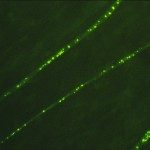Lien vers Pubmed [PMID] – 16188991
J. Virol. 2005 Oct;79(20):12893-904
To study the capacity of human neurons to mount innate immunity responses to viral infections, we infected cells of a human postmitotic neuron-derivative cell line, NT2-N, with rabies virus (RABV) and herpes simplex type 1 (HSV-1). Changes in neuronal gene expression were analyzed by use of Affymetrix microarrays. Applying a twofold cutoff, RABV increased the transcription of 228 genes, and HSV-1 increased the transcription of 263 genes. The most striking difference between the two infections concerns genes involved in immunity. These genes represent 24% of the RABV-upregulated genes and only 4.9% of the HSV-1-upregulated genes. Following RABV infection, the most upregulated genes belong to the immunity cluster and included almost exclusively genes for beta interferon (IFN-beta) primary and secondary responses as well as genes for chemokines (CCL-5, CXCL-10) and inflammatory cytokines (interleukin 6 [IL-6], tumor necrosis factor alpha, interleukin 1 alpha). In contrast, HSV-1 infection did not increase IFN-beta gene transcripts and triggered the production of only IL-6 and interferon regulatory factor 1 mRNAs. The microarray results were confirmed by real-time PCR, immunocytochemistry, and enzyme-linked immunosorbent assay. Human neurons were found to express Toll-like receptor 3. They produced IFN-beta after treatment with poly(I:C) but not with lipopolysaccharide. Thus, human neurons can mount an innate immunity response to double-stranded RNA. These observations firmly establish that human neurons, in absence of glia, have the intrinsic machinery to sense virus infection.

